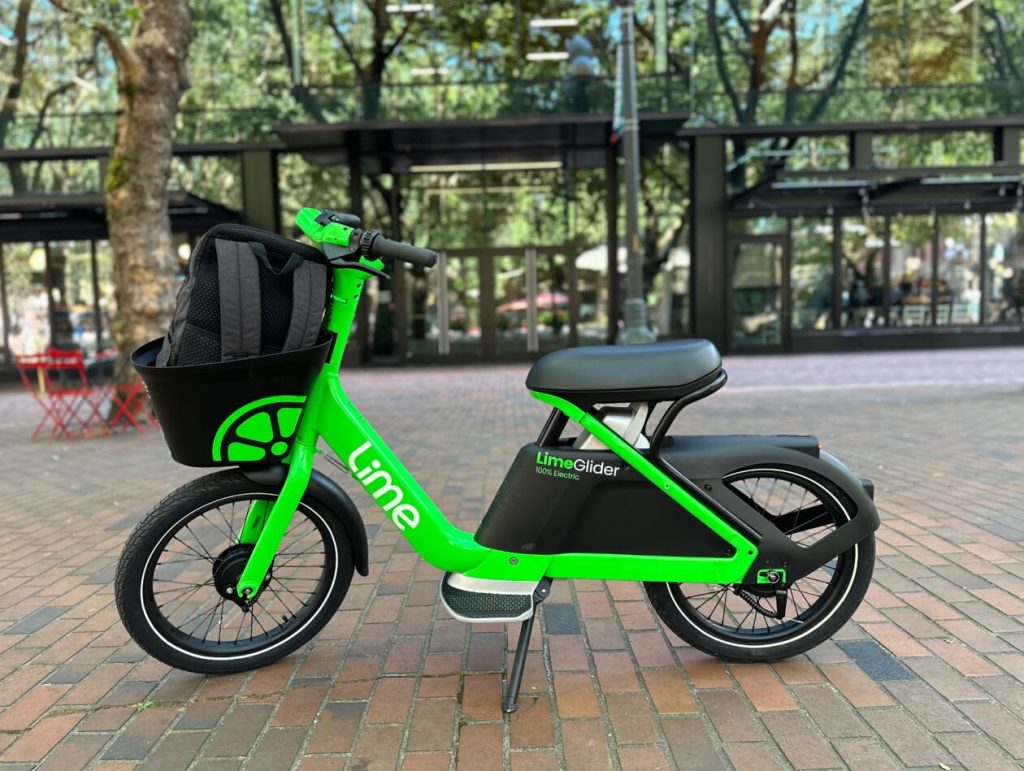Summarize this content to 2000 words in 6 paragraphs
Lime’s new LimeGlider will hit Seattle streets starting Oct. 12. (GeekWire Photo / Kurt Schlosser)
I’ve had some scary wobbles riding scooters on some of Seattle’s less-than-smooth roadways. Thankfully I’ve never hit the pavement. But during a test ride Wednesday, I may have fallen for Lime’s latest electric micromobility device.
The new “LimeGlider” is coming to Seattle on Monday in the first pilot anywhere on the planet for the half e-scooter, half e-bike. Lime will roll out 280 of the green and black sit-down devices in the University District to test how well they are received in a city where the company has been operating since 2017.
With 10,000 bikes and scooters already on Seattle streets as part of the Scooter and Bike Share program run by the Seattle Department of Transportation, Lime calls Seattle a global leader in this form of transportation. And now it aims to see if the LimeGlider will attract even more first-time riders.
It’s easy to see how that might happen. Bikes are not for everyone, especially in a hilly city where electric pedal assist only does so much assisting. And scooters can be sketchy, especially in traffic where standing on a tiny-wheeled device can leave riders feeling pretty vulnerable.
Lime calls the LimeGlider its most “inclusive ride to date,” with a step-through frame, larger seat, thumb-operated throttle, foot platforms, and low center of gravity.
The LimeGlider thumb throttle is near the right handgrip. And an improved phone holder above the speedometer features a sliding clamp to fit various phone sizes. (GeekWire Photo / Kurt Schlosser)
The LimeGlider battery sits below the seat to transfer that weight away from the front of the device. There is also a handle at the back of the seat to help users maneuver the LimeGlider over curbs. (GeekWire Photo / Kurt Schlosser)
Other design tweaks include a wider front cargo basket and an improved sliding clamp phone holder that’s front and center for those who use navigation maps.
And if you’ve ever struggled to move a regular Lime bike off the sidewalk, the LimeGlider also features a handle beneath the seat that makes it easy to lift and maneuver the heaviest part of the device over curbs, etc.
I took off on my test from from a spot near City Hall, at Fourth Avenue and Cherry Street. Using the two-way bike lane on Fourth, I headed south toward Pioneer Square.
Like Lime’s other devices, the LimeGlider tops out at 15 mph. The thumb throttle, which is also coming to new Lime bikes, was easy to use and got the LimeGlider up and running from a stopped position with no difficulty.
I was most impressed by the feeling of stability, sitting low over the center of the device with my feet up. The wheels felt especially solid on bumpier portions of the bike lanes and navigating some of Pioneer Square’s rougher streets and cobblestones.
Here’s a quick video of me cruising down Fourth Avenue:
The LimeGlider climbed back up Second Avenue with zero issues. It was nice to come to a stop and simply put my feet down on the pavement. Sometimes with Lime bikes, getting seat height just right after the last rider can be a hassle.
I saw a number of Lime scooter and bike riders around that part of downtown during my ride, and asked one, who had just parked a scooter, what he thought of the LimeGlider I was seated on. He said he still preferred the scooter because he liked to stand up and not have his pants fall down or shirt ride up while seated. Maybe Lime can make a unisex onesie for such riders.
Headed back toward my meeting spot, I challenged the LimeGlider to make the climb from Second to Fourth on Cherry Street, and as the speed dipped to 7 mph, I thought I might have to turn around on the steep grade. But with a couple pushes from my feet, the device did get me to the top.
Lime and Bird are the last two currently standing in the city’s shared scooter/bike program that has attracted a variety of companies over the years. Wheels and Veo previously operated sit-down-style devices in Seattle.
The LimeGlider pilot in the U. District will last three months before wider rollout. In a city where residents and visitors took over 3.1 million rides on Lime vehicles in 2023, numbers may rise with another device in the mix.
The LimeGlider stacked up against a herd of Lime scooters and bikes in downtown Seattle. (GeekWire Photo / Kurt Schlosser)


